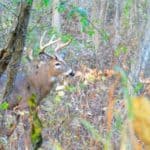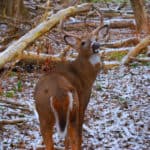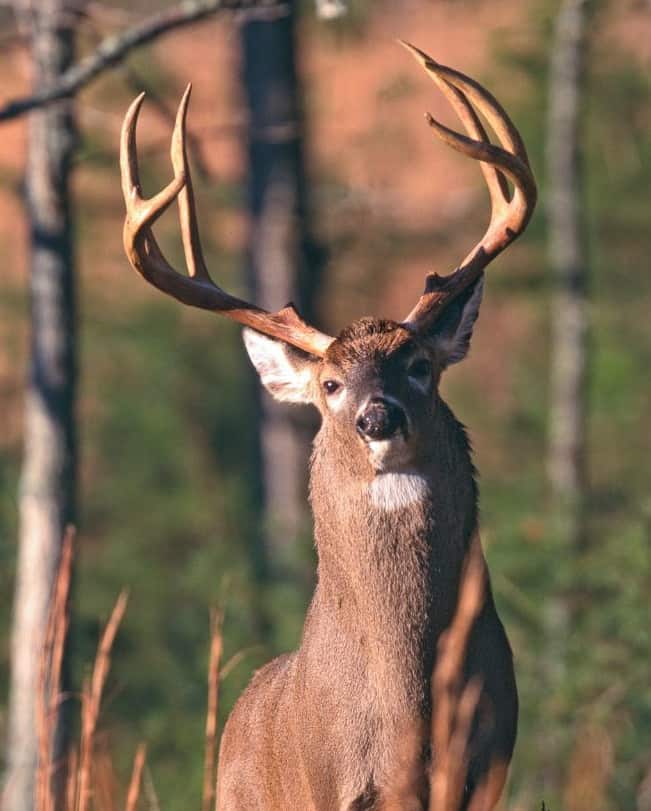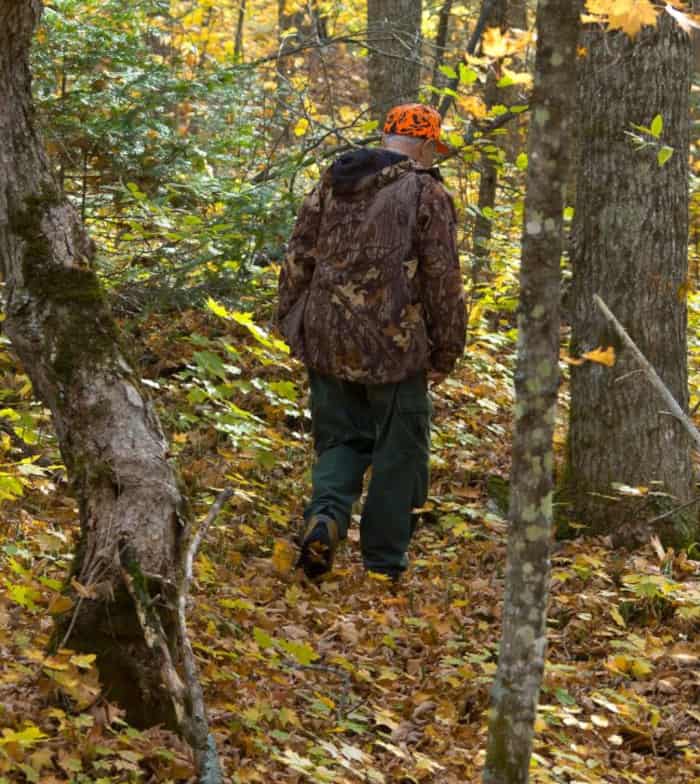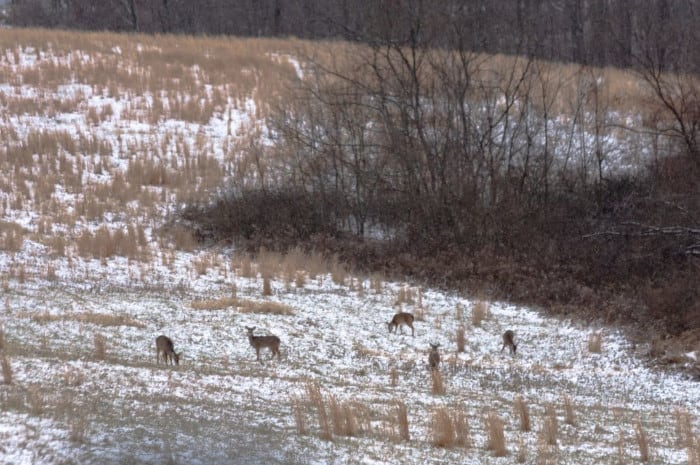Being a successful deer hunter requires skill, perseverance, and some luck. Developing or improving your hunting skills can mean the difference between filling your tag and coming home empty-handed. One skill that every deer hunter should consider adding to their bag of tricks is antler rattling. Learning to rattle antlers is an efficient hunting tactic that can bring in mature bucks. However, rattling isn’t ideal for every hunting situation, so this post will be an introduction to antler rattling and provide some suggestions for the best time of year to rattle for bucks.

What is Antler Rattling for Whitetails
Antler rattling is a technique that imitates the sounds of two whitetail bucks clashing their antlers together as part of a fight (also called sparring). During the deer mating season, bucks become territorial and aggressive while searching for female deer (does) in estrus (ready to mate).
As part of that aggression, they will spar with other male deer in an effort to:
- Defend their territory
- Drive other bucks away from does in heat
- As a means to attract does in estrus
As a hunter imitates the sound of two bucks fighting, it can attract mature bucks looking to mate or drive rival bucks away from the available does. In addition to attracting mature deer with antlers, rattling can lure in does and younger smaller antlered deer, who are drawn based on curiosity.
Will Rattling for Deer Work Anywhere?
In my experience, rattling for whitetails can work anywhere, but there are factors that can influence its effectiveness. Those factors include the following:
Doe to Buck Ratio
The doe to buck ratio (also called the buck to doe ratio) is a self-explanatory ratio number. The lower the percentage of female deer to male deer generally equates to a better buck response to rattling.
As the ratio of does to bucks increases, it begins to impact the effectiveness of rattling. You can still potentially rattle in bucks, but fewer will respond. In my experience, rattling becomes a less and less effective option when the does-to-buck ratio gets to the 6-1 or 7-1 number.
I’ve experienced my most successful rattling in the 1-1 and 1-2 ratios. However, I wouldn’t rule out antler rattling strictly based on perceived doe-to-buck ratios because you only need one mature buck to respond, and you’re in business.
Level of Hunting Pressure
There also seems to be a correlation between the volume of hunting pressure in an area and the effectiveness of rattling antlers.
Rattling antlers in areas that experience higher volumes of hunting pressure and hunters in the woods generally equates to less effective rattling results. I suspect the number of hunters in the woods makes whitetails less willing to investigate a simulated battle between two bucks. That’s not to say that deer won’t respond to a rattle on public land or highly hunted land, but I find it far less effective compared to rattling on private lands.
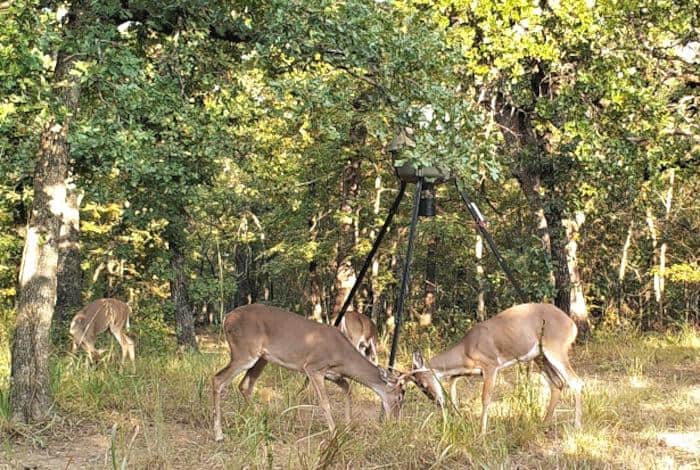
Antler Rattling Safety
Before I get too deep into the basics of rattling antlers, I want to touch on hunter safety when it comes to rattling.
Wearing Orange
When antler rattling, I always recommend you utilize some hunter orange clothing, whether legally required or not.
While rattling, you’ll be holding a set of real antlers or simulated antlers and making sounds that mimic two bucks fighting. That noise and activity may attract other hunters, especially those who prefer to still-hunt or stalk versus hunting from a stand. I’ve had a few bow hunts on public land, where I rattled in more hunters than deer.
Another potential safety concern with rattling can occur when traveling through the wood to your preferred hunting location. In that situation, you may be waking through the woods to get to your hunting spot carrying, wearing, or holding a set of deer antlers. Wearing hunter orange as you travel to your stand reduces the chances of another hunter mistakenly seeing you as a shootable buck walking along.
For those reasons, I strongly suggest wearing some type of hunter safety clothing.
Rattling on Public Land
Deer hunting on public land or state-managed tracts can create some additional safety risks when calling or rattling for whitetails. Therefore, when rattling on public lands, I generally use the following guidelines:
- Rattle and call during archery season but only from a tree stand or elevated stand.
- I avoid any rattling or calling on public land during gun season unless I’m in a remote area that I feel comfortable has no other hunters.
- I avoid rattling or calling on public land when hunting on the ground in archery or gun season via a blind or still hunting unless I know the area has no other nearby hunters.
Although I haven’t personally had any close calls or overly dangerous situations while hunting on public property, I have rattled in a few fellow hunters. As such, I try to adhere to these guidelines for safety purposes. Note that these are just my guidelines, so feel free to adjust or change them as you see fit.
Antler Rattling is Another Deer Hunting Tool
Here are a few other things I’d like to mention about antler rattling:
Rattling is not Foolproof and Not a Guaranteed Way to Harvest a Mature Buck
As with any other hunting technique, there are times when rattling is effective and other times when it flat out won’t work. It’s just another tool to use in your arsenal of deer hunting techniques.
I’m always amazed at the hunters who swing into the sporting goods store I work at on Friday to pick up some rattling antlers or a rattle bag and then are back in the store Sunday afternoon trying to return them because “they don’t work.” It takes time to learn how to rattle and when to rattle.
Rattling is No Substitute for Hunting Basics
Rattling for deer is only effective if used in conjunction with deer hunting basics like:
- Proper Scent Control
- Stand or Hunting Location
- Pre-Season Scouting
You can be the best antler rattler on the planet but won’t have much success if you don’t take some scent control measures or hunt an area with little to no deer population.
Again, rattling is just one skill or technique to add to your existing repertoire of deer hunting methods.
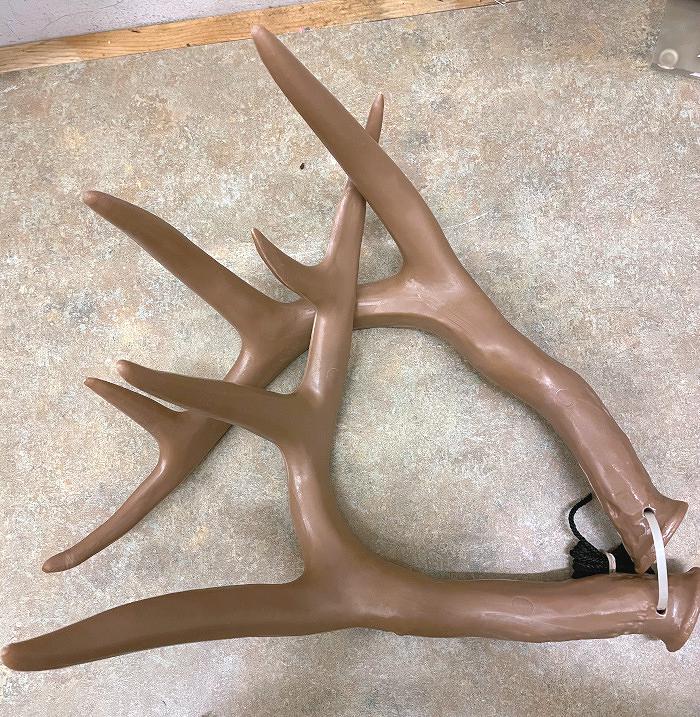
When is the Best Time to Rattle for Bucks?
There are four factors that play a role in the effectiveness of rattling antlers to attract bucks, and those are:
- Rut Phase
- Time of Day
- Weather
- Hunting Pressure
Let’s look at each factor in greater detail.
Rut Phase or Phase of the Rut
The term “rut” is loosely defined to describe the whitetail deer mating season. During the mating season, bucks change their behavior due to the biological drive to mate. As their bodies flood with testosterone, they become aggressive towards other male deer and territorial with a drive to establish a mating hierarchy.
Most deer biologists and hunters break the rut into three phases, but I prefer to use four. Some sources even divide the rut into seven or eight phases. Here’s an overview of each stage and the potential role that rattling can play in each phase:
Pre-rut Phase
The pre-rut phase is generally considered the ten-day period leading up to the actual rutting or mating period. In the pre-rut phase, bucks begin to protect their territory and show some dominant behavior to establish a clear hierarchy for the upcoming mating season. For example, they will start to separate from other groups of bucks and visit the scrapes and rubs that define their territory.
I’ve had some success rattling in bucks during this phase, but the sheer number of bucks who respond is low compared to the number that responds during the full rut. However, even though the number of bucks who respond to rattling during the pre-rut is smaller, most are mature bucks.
If you’re trophy hunting, this can be an effective phase to rattle.
Full Rut
In this phase, the does are in full estrus and ready to mate. Bucks will aggressively search for, protect, and mate with as many does as he can locate. This full rut stage is when male deer only have one thing on their minds: mating. They barely eat, barely rest, and are biologically driven to pursue females.
The complete rut phase is a prime-time period for antler rattling. Rattling and calling are the most effective techniques in this phase, as bucks lose all common sense. This is the phase where you hear stories about bucks running full speed over towards a hunter who rattled with little to no caution.
In this phase, you’ll see the most significant number of deer respond to rattling, but most will be smaller bucks. Likewise, you may have a big boy answer, but most will be spikes, fork horns, and more minor four-pointers.
Post Rut
The post-rut phase occurs when the initial rut phase winds down as does come out of estrus. In this phase, most bucks spend a significant amount of time resting or eating as they are trying to fatten back up. Most bucks lose a considerable amount of weight during the rut, so they desperately need to replenish their body weight and fat storage.
The effectiveness of rattling begins to wind down in this phase, although some bucks will still respond. Although the number of deer that respond will drop, the number of mature deer that respond goes up. My largest buck (to date) harvested with a bow came into antler rattling during this phase. And he came right to me fast and ready to fight.
If you’re in the woods during this phase, I would not hesitate to give rattling a try.
Secondary Rut
After the initial rutting period, there’s a smaller, second rutting period where the second wave of does comes into estrus. It’s generally a much smaller number of does compared to the full rut.
This phase is usually late in the hunting season, and most bucks are still recovering from the initial rut. However, they are biologically driven to respond, so some chasing, fighting, and mating will occur in this phase. However, the volume of that activity is much smaller than what is typically observed during the full rut.
If you haven’t bagged a buck yet or are still looking for your next wall-hanger, it’s worth hitting the woods during the secondary rut. While the number of male deer that respond to a rattle is less, the ones that do respond are typically good-sized bucks.

Best Time of Day to Rattle
The time of day also plays a role in the effectiveness of antler rattling, especially during certain parts of the rut.
During the full rut, I have bucks respond to rattling throughout the day. Morning, mid-day, and evening, they will come in.
However, during the other rut phases, early to mid-mornings seem to be the best time to rattle for whitetails. Outside of the full rut phase, I’ve had the most success, and most bucks respond to an antler rattle from first light up to late mid-morning.
To be fair, I have been able to rattle in a few bucks in the evening hours but have far more success in the morning hours.
However, research conducted by various hunter-related groups has conclusively proven that mornings are the best time to rattle.
Weather Matters
In addition to factors like the rut period and time of day, the weather also plays a role in deer rattling success.
Although I’ve had bucks respond to rattling under just about any weather situation, there are weather conditions that seem to perform better than others. For example, bucks that are bedded down and not moving around won’t typically bother to get up and investigate a potential sparring match. So, weather situations that get the deer up and moving seem to be better-suited conditions for rattling success.
Here are some weather situations that seem better than others:
Colder weather
I’ve had far better success rattling during colder weather versus warmer weather. That being said, temperatures that are abnormally cold (frigid) seem detrimental to rattling as the deer seem to stay bedded down longer than usual.
Windy Conditions
Windy conditions don’t seem to be a good fit for rattling. Wind noise reduces the distances from which the rattle activity can be heard and may make it difficult for deer to identify the direction in which the rattle sound originated.
Personally, I’ve had no success rattling during windier conditions.
Light Precipitation
Light precipitation conditions appear to be ideal for this type of activity. I’ve had better than average success in light rain and light snow. However, light seems to be the operative word.
Heavier precipitation seems to be a lousy option for rattling, as I’ve had no success bringing in deer during heavy rain or heavy snow.
I’ve also had success rattling and calling during morning fog, especially mornings with frost on the ground.
Cold Front
I’d definitely try rattling just before and right after a cold front comes through. I’ve had good success with both, although just before a cold front seems to perform better than just after one.
Level of Hunting Pressure
I mentioned hunting pressure previously, but I wanted to revisit the topic in more detail. The volume or amount of hunting pressure will play a role in your success or failure when antler rattling.
The more hunting pressure exerted on deer, the less apt they are to respond to any type of rattle, even during the peak of the rut. This is especially prevalent on public hunting land crawling with deer hunters during various rut phases.
When bucks are pressured endlessly, they will generally take one of two approaches:
- Venture into the thickest, most remote area within their territory
- Relocate to a new territory
Neither approach is good for a hunter trying to rattle in a buck on public land.
I grew up in Kansas and hunted several different state-managed hunting tracts in the state. Some of those public land tracts are crawling with hunters during deer season, especially during the first two weeks of each season.
I can recall times when I was in a stand during the peak of the rut and saw several deer, but not a single buck responded to rattling. Instead, most of the deer were sneaking down draws or creek beds, heading towards some private land just to the north.
Now, I’m not saying that you can’t rattle a buck in on a heavily hunted area, but it’s much more challenging than calling one in that has seen little to no hunting pressure.
Like most deer hunting techniques, rattling is a learned skill in both rattling techniques and knowing when to rattle. But, under the right conditions, it can be an incredibly effective way to draw in a monster buck.
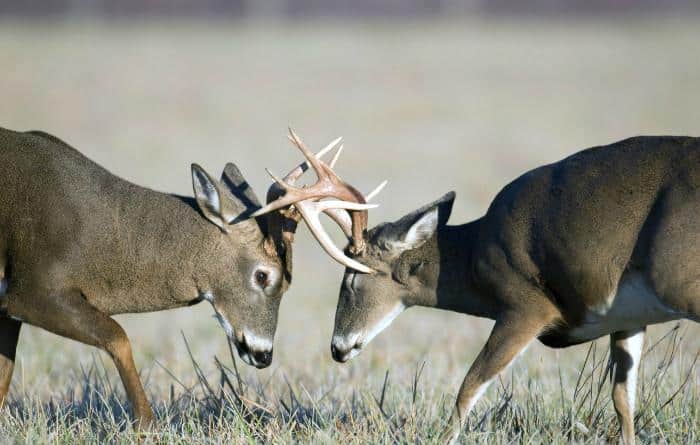
FAQS
Here are some of the commonly asked questions that I’ve either been asked or seen asked concerning times to rattle deer:
Does rattling work in the evening?
Most deer researchers and hunters have discovered that rattling in the morning hours is more effective than any other time of day. However, I have had a few deer respond to an antler rattle in the evenings during the rut, but I have much better success in the morning and mid-day hours.
I won’t say rattling in the evening won’t work, but the odds of success are better in the morning.
Should you rattle during early bow season?
As a fellow bowhunter, I would say that the answer depends on the time of year that bow season comes where you hunt and the time of year when the rut occurs.
If your bow season starts in September, and the rut in your area begins in mid-November, then I probably wouldn’t rattle early in the early bow season. However, I would start trying a rattle towards the end of September as the pre-rut phase is just getting ready to kick off.
I’d base my decision to try rattling during bow season in relation to when the rut occurs in my hunting area. If the bow hunting season coincides with any rut phase, then I’d definitely give rattling a try. If it doesn’t, I would skip rattling and focus on other techniques.
Should you rattle during peak rut?
I would absolutely rattle during the peak of the rut as it’s the best time of the year to draw in deer through rattling and calling. The only time I would suggest not rattling during peak rut would be a situation where doing so could cause some hunter safety issues. For example, I wouldn’t rattle while hunting on public land from a ground blind during gun season.
Should I try mid day rattling for deer?
Antler rattling during the mid-day hours can be very effective, especially during the pre-rut and rut phases of the deer life cycle. I’ve had good luck rattling in mid-day, especially on public hunting land during bow season.
Hopefully, you found this information helpful in identifying the ideal times to use antler rattling, and I’ll update this information as I come across new questions to answer.

Born and raised in Indiana, Brantley spent his youth chasing deer and turkey and, along the way, developed a passion for bowhunting. Although he still enjoys other types of hunting, his true passion is bowhunting, and he has or will author most all the bowhunting content on this site. Outside of work, Brantley is married and the father of two beautiful little girls. Brantley has worked in the hunting industry, with an emphasis on archery and bowhunting, for more than ten years.

